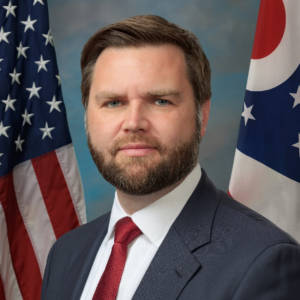What’s old is new again in presidential politics. And it’s been a mighty long wait. For the first time in nearly a century, there’s a candidate with facial hair on a major party’s ticket.
Ohio Sen. J.D. Vance, as the Republican vice-presidential candidate, is a big boost for hirsute aficionados. The last top elected tonsorial trendsetter was the mustachioed Vice President Charles Curtis, who left office in March 1933. D.C. has been clean-shaven since.
It’s been that way through much of the republic’s history. And it was all due to — who else? — George Washington.
The Father of Our Country was venerated almost to the point of sainthood in America’s early days. The standards he set in office were scrupulously followed by the presidents who initially came after him. George served only two terms, so that was good enough for them. He created the Cabinet, where his various secretaries could offer advice, so they did likewise. And he was clean-shaven. So were the next 14 men who followed in his presidential footsteps.
Until Abraham Lincoln came along and broke with precedent.
Lincoln may have been a lot of things, but nobody ever confused him with a GQ model. His face is so iconic today, so widely seen and instantly recognized that we have collectively forgotten what a homely guy he really was.
Lincoln himself was quite aware of his lack of good looks. When a rival accused him in a debate of being two-faced, Lincoln calmly replied, “If I had another face, do you think I’d wear this one?”
So, it’s ironic that a picture helped propel him to the presidency. During a visit to New York City in early 1860, he posed for famous photographer Mathew Brady. He also gave a very well-received speech at the Cooper Institute. His campaign team distributed thousands of copies of the image and countless copies of the speech to promote his candidacy. He later said, “Brady and the Cooper Institute made me president.”
It was the clean-shaven, gaunt-cheeked Lincoln who was elected that year. But when the votes were all counted, he did something radical.
Lincoln grew a beard.
Even 160-plus years ago, image was everything in politics, just as it is today. The Rail Splitter knew he was rocking the boat of tradition by letting his whiskers grow. Shrewd politician that he was, he likely used it to appeal to the younger crowd. Because beards were becoming fashionable among young men as the Swinging Sixties got underway. (Incidentally, history would repeat the trend 100 years later.)
As the 1860 campaign entered the home stretch that October, 11-year-old Grace Beddell in Westfield, N.Y., wrote a letter to the Republican candidate.
“I have got four brothers and part of them will vote for you anyway, and if you let your whiskers grow I will try to get the rest of them to vote for you and you would look a great deal better for your face is so thin. All the ladies like whiskers and then they would tease their husbands to vote for you and then you would be president.”
Lincoln’s reply was politely non-committal.
“As to the whiskers, having never worn any, do you not think people would call it a silly affectation if I were to begin it now?”
But in November, he put down his razor. And when a train chugged out of Springfield, Ill., on Feb. 11, 1861, carrying him to Washington, he was the bearded figure we know today. When that train stopped in Westfield a week later, he told a crowd that had gathered to meet him, “Some three months ago, I received a letter from a young lady here. It was a very pretty letter. She advised me to let my whiskers grow. If she’s here, I would like to meet her.”
A boy cried, “There she is, Mr. Lincoln,” and pointed to a blushing Grace. Lincoln hopped down from his railcar and hurried over to her. He gave her several kisses, and they chatted amiably for a few minutes. Then, it was back onboard for the remainder of his trip into history.
Of the next 10 presidents who came after Lincoln, all except Andrew Johnson wore a beard or mustache. Woodrow Wilson ended the facial-hair streak with his election in 1912, and it’s been an unbroken series of cool, clean presidential shaves ever since. (Wilson’s veep, Thomas Marshall, sported a mustache, and except for the aforementioned Curtis, the country’s succeeding second bananas have all been smooth-shaven as well. Kamala Harris included.)
So, if Vance is elected in November, could it herald the dawn of a second Golden Age of Washington Whiskers? If he loses, will his beard become the answer on the back of a future Trivial Pursuit card?
Asked about Vance’s beard in a recent interview, Donald Trump said, “He looks like a young Abraham Lincoln.” You can’t help wondering if Grace would have agreed.





